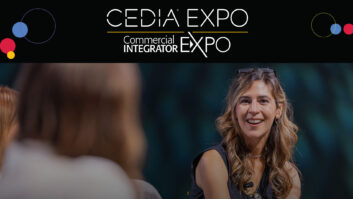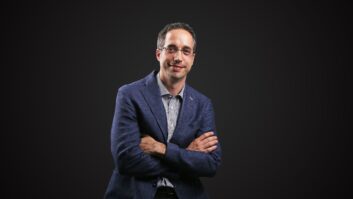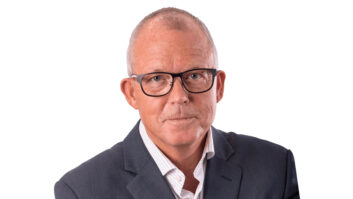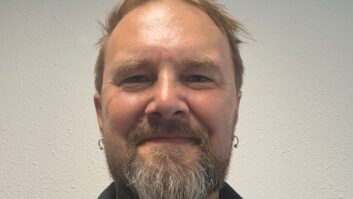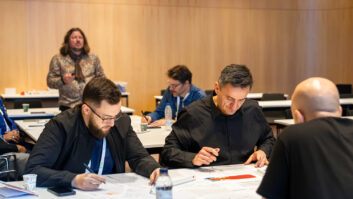Possibly the most successful innovation at CEDIA Expo this year was the Designing Interiors with Technology conference. Just over 100 interior designers and architects visited the second day of the Expo to find out more about residential technology and the work of CEDIA and its members. Paddy Baker spoke to Fraser Stride, CEDIA outreach chair, who led the organisation of this event.
Q: Was there a key moment in the day for you?
A: Utz Baldwin, CEO of CEDIA in the US, gave a 15-minute talk, during which he asked all these interior designers to hold up their hands if they were seeing technology more and more in the projects they’re working on; pretty much everyone held up their hands. Then he asked if they were confident in talking about technology; about one person held up their hand. Then he asked if they wanted to be confident in talking about technology – and pretty much everyone raised their hand.
That was a good indication that everyone was there because they realised that technology is becoming more and more important, and they need to be aware of it as part of their jobs – which was nice to see. I think we may have hit the tipping point in terms of acceptance that this is the way forward, and these people need to understand it as opposed to ignoring it, and realise that it’s part of producing a professional result for their clients. That was a really nice reaction from the crowd.
Q: What was the content of the educational sessions?
A: The aim was to show what’s possible, to give them confidence when talking about technology, to improve their vocabulary. Our technology is either there to help you hide things away – some clients don’t want to see any equipment – or to help you make a feature of technology. Also we were trying to make sure they were aware of considerations for things like cabling, space for equipment, ventilation, that kind of stuff. Also, we wanted to communicate that we need to be involved in a project at an early stage and that the design of what we do as professional installers is critical.
First, Jane Scotland (CEDIA marketing chair) gave a taster of CEDIA’s CPD – continuing professional development offering, ratified by RIBA.
After that Malcolm Stewart of Kensington Home Technology gave an ‘A-Z of technology’ talk giving an overview of various technologies – what’s Cat5, what’s HDMI, what does lighting control mean? It was really a way of improving designers’ vocabulary of technology, and raise their confidence in talking about it.
Then there was Utz Baldwin’s speech, and after that we had a presentation from Lucy Martin of John Cullen Lighting, which was focused on lighting aesthetics, the different types of lighting available, and lighting control – and again, there was the message that is something that, if you want it in your project, you need to be thinking about from an early stage.
The last presentation was from Angus Gibson of Gibson Music. It was basically focused on technology – and about what’s media hype and what’s real. In the press, you read about the latest bit of kit, the latest cable or whatever, but that doesn’t mean that we need to be jumping on it straight away. In our industry, the most important part of anything we do is reliability, and any cutting-edge product always takes time to become stable. So Angus was trying to help people to understand that just because something is the latest and greatest, that doesn’t necessarily mean it’s the right solution. And again, trying to give examples of different project – what works well, and the sort of things that CEDIA members can do in terms of integration.
Q: And then there was a booth tour?
A: After lunch, we split the people up into 12 groups, and then 12 volunteers – from the board and other CEDIA members – took a group of designers and architects around the show floor. Each group was given a list of ten manufacturers visit – which was there to make sure that all the manufacturers got some airtime with these guys.
Before these tours, we went round and talked to the different manufacturers and let them know that there would be coming to their stand with a group of specifiers, to make sure that they would be talking in their language, and showing products that were relevant. So if you’re showing someone a rack stand, the key is not to talk about the details of racks, but to show people how big these things are, why they need to allow space for them and so on. That’s a good example of why it’s still important to show designers relatively unsexy products. At the other end of the spectrum you’ve got companies like Artcoustic, Future Automation and Amina – great design-led technologies that are always very popular.
The tour lasted anywhere from half an hour to an hour and a half, depending on the groups. Before we started, we weren’t too sure how people would feel – we didn’t want them to feel that they were being ferried around. But after we’d visited a couple of stands, we asked if this approach was helpful or if they would prefer to go off an do their own thing. Every group said it was really helpful, and that they really appreciated having a tour guide who could introduce them and make it very clear what was important to them.
Having small groups also gave them confidence to ask questions about the products they were seeing, with regard to projects that they were working on themselves. When you have a group of 100 people, no-one wants to ask a question. But in my group, we had 20 or 30 questions asked. If you multiply that by 12 groups, that’s around 300 questions – which is brilliant.
I spoke to all the board members afterwards, and the feedback from every single one of them was that the seminars in the morning was very valuable and the tours were absolutely fantastic.
Q: I heard that someone on one of the tours was almost of the point of placing orders on the booth tourÖ
A: We had to help them understand that the whole point of coming to a CEDIA member is that we will do that for them – we’ll deal with the manufacturers and take the design work to them. I think that was a key thing to understand. For instance, if you look at the Future Automation stand [motorised mounts etc] and the products looks amazing, then you’ve got to think, “How are we going to build this, how are we going to design it, what cable do we need?” and so on.
Although they were like “We really want your product”, we were there to say, “If you like this product, through a CEDIA member we can help you design exactly what you’re trying to achieve and work with the manufacturer. You tell us what you to do, and we’ll translate that into making it happen.” I think making them understand that is really important, as it makes it clear that there’s a link between them and the product, which is the CEDIA member.
Q: So what do you see is the benefit of this to the average CEDIA member?
A: We have constant feedback from our members that they want that CEDIA badge to mean more and be better understood. People, whether they’re specifiers or clients, need to recognise that a CEDIA member will give a quality installation for them.
An event like this raises the profile of CEDIA to these interior designers, which is absolutely critical for making sure that when they want to do something that involves what we do, their first port of call is CEDIA, which then cascades down to the members.
On the flipside, it’s also very important to give them confidence with the technology and show them that that it’s not just about big tellies, it’s about some really quite clever stuff as well. When you can open their eyes to what’s possible, they can really start to understand how that can benefit what they do – and make their schemes better. Once you do that, you increase their thirst for technology, which then cascades through their clients and ultimately comes back to CEDIA by creating demand through the clients of CEDIA members.
Q: So you’ll be doing something like this in the future?
A: We’ll definitely do it again next year. Feedback from one of the interior designers was that we should do it at least once a year, which was nice to hear. Given that it was the first time we’d done it, it was a huge success, a great achievement – not just in terms of the numbers who attended but in terms of the feedback they gave.
We want to show commitment to our members that we’re trying to do what they’ve asked: in this case, manufacturers said they wanted interior designers at the show, and we got them there and we educated them at the same time. So I hope our members can see that the reason we did it was in response to their feedback, and we’re trying to do what’s best for them.

